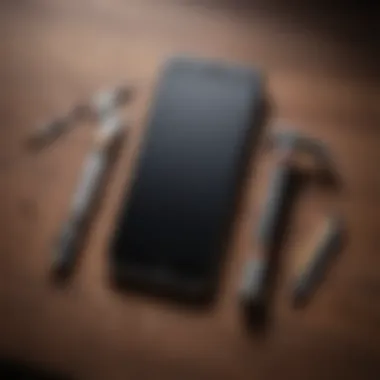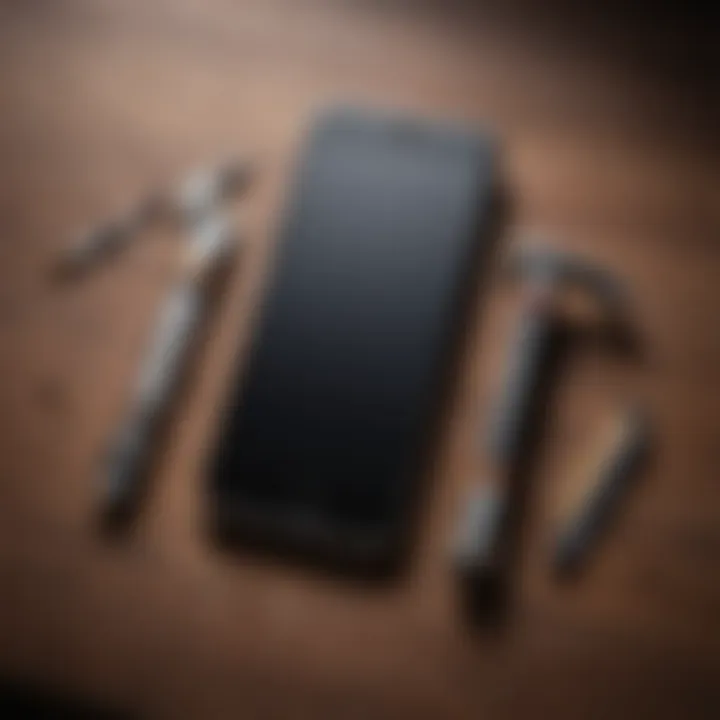Cloning an iPhone: A Comprehensive Guide for Data Transfer


Intro
Cloning an iPhone involves transferring your data from one device to another smoothly and effectively, an important task for users upgrading their phones or resetting their devices. In this guide, we will explore various methods available for cloning iPhone data. From the built-in features in iOS to third-party applications, this guide intends to equip you with knowledge to perform the task proficiently.
The relevance of cloning data cannot be overstated. Many users rely heavily on their smartphones for everything from personal contacts to sensitive information. Thus, understanding how to clone can provide peace of mind during transitions to new devices.
In the following sections, we will present detailed insights into the processes involved in cloning. By targeting both novice users and experienced individuals, this guide emphasizes practical solutions while respecting technical implications. Let's better comprehend what cloning an iPhone entails.
Product Overview
When discussing cloning iPhones, it is essential to consider iPhone's features and specifications. Apple's products, mainly iPhones, have become cornerstone devices in many users' lives. They are designed with elegance and functionality in mind.
Key features of the iPhone include the following:
- Retina Display: Offers vibrant colors and excellent visuals, enhancing content consumption.
- A-Series Chips: Provides remarkable processing power, enabling smooth multitasking and high-performance applications.
- iOS: Featured layout and wide variety of apps for optimal user experience.
As for design and aesthetics, iPhones are characterized by their sleek and modern silhouettes. The choice of high-quality materials conveys premium quality, creating an attractive look.
Performance and User Experience
User feedback on the performance of iPhones often points to their reliability and ease of use. Performance benchmarks on recent models indicate excellent responsiveness, even when multitasking.
The user interface of iOS complements the hardware abilities, offering a streamlined operation that is accessible for all users. Overall, usability contributes to the broad positive reception and preference for Apple products among tech aficionados.
Comparison with Previous Models or Competitors
The transition from older iPhone models to current ones has featured impressive advancements. Each new iteration delivers better camera systems, enhanced battery life, and overall system efficiency.
Comparatively, the latest models have outperformed competitors in aspects such as software integration and customization options. iPhones tend to maintain higher resale values and a loyal user base when ranked against similarly priced smartphones in the market.
Tips and Tricks
To optimize the process of cloning an iPhone, here are some useful tips:
- Use the Quick Start feature for a seamless transfer during initial device setup.
- Take advantage of iCloud Backup to keep data backup up to date.
- Regularly update your software for compatibility and security.
Hidden features like Manage Storage settings reveal how well-organized your data is. Knowing these small elements can alleviate common issues relating to storage and performance.
Latest Updates and News
Staying informed about the latest updates in iOS enhances the cloning process tremendously. Recent software updates address security, stability, and compatibility issues, providing more efficient cloning methodologies.
Watch for industry announcements from Apple. Occasional rumors or news about new product launches predict relevant advancements or bring changes that could improve the data transfer experience further.
Knowledge of both new and existing features assists in making informed choices concerning one's device.
In summary, while cloning data from an iPhone may seem an intimidating task at first glance, understanding the processes, features, and practical strategies available makes it manageable. This guide serves as your comprehensive resource tailored to enhance your cloning experience.
Prelude to iPhone Cloning
Cloning an iPhone involves copying data and settings from one device to another. This topic is essential, as it addresses the need for data migration between devices when upgrading or switching iPhones. As an Apple user, understanding the cloning process helps in maintaining continuity and saving time. Whether you're transitioning to a newer model or need to send your device for repairs, efficient cloning can enhance the experience.
Understanding iPhone Cloning
iPhone cloning encompasses transferring data including contacts, messages, apps, and media from your existing device to a new one. When executed correctly, users experience minimal downtime, enjoying a seamless switch on their new device. The risks of losing valuable data during transitions highlight the clonal process's significance. Comprehending technical capabilities and potential pitfalls can notably ease anxiety about switching between devices.
It is necessary to note that the cloning process varies among different iPhone models and versions of the iOS. Newer features may permit faster, more effective cloning, while older generations may demand more conventional methods, like iTunes, for data transfer. Therefore, understanding these distinctions elevates the likelihood of success when guiding through cloning.
Reasons for Cloning an iPhone
Understanding the motivation behind cloning helps refine focus on the entire process. Reasons for cloning an iPhone often include:
- Upgrading Devices: When a user acquires a new iPhone, it is expected to import the existing data efficiently.
- Electronical Fault: If an existing iPhone develop issues before fail entirely, making a clone allows to save pivotal information and vital functionalities.
- Shared Usage: Devices sometimes need rearrangement. A new user might require the preceding owner’s data for effective usage until personal settings are established.
- Data Monitoring: Cloning serves as an option for familiarizing with operating systems without starting from scratch.
Establishing the value of cloning outside routine device upgrades can lso foster awareness surrounding applications of this technology in various contexts. For example, management professionals might share a keener interest in data transitions within a business context, implementing solutions custom to enterprise frameworks.


Although the act of cloning iPhones may present difficulties at times, system advancements push the efficiency envelope regularly. The current utility built in between Apple’s Safari and iCloud promote efforts to simplify the end-user struggle when converting to a newer model.
“Data transfer processes in modern devices are designed to offer convenience, and iPhones are no exceptions.”
Preparing for the Cloning Process
Preparing for the cloning process is a crucial phase that cannot be overlooked when transitioning from one iPhone to another. This stage lays the groundwork for a successful data migration and prevents issues that can arise later. Understanding the right steps to take will not only save time but will also ensure that data integrity is maintained throughout the process.
Before starting the cloning process, it’s important to consider the consequences of not preparing properly. If one fails to back up existing data or improperly configures the new device, it can lead to frustrating situations such as losing critical files. Additionally, insufficient preparation may complicate data recovery if difficulties emerge after the cloning is attempted.
In this section, we will delve into the specific tasks needed to prepare effectively. This includes creating reliable backups of your existing iPhone as well as ensuring that the new iPhone is set up correctly. Both of these preparatory steps significantly contribute to a seamless data transfer experience.
Backing Up Your Existing iPhone
Backing up your existing iPhone is an essential step in the cloning process. This action safeguards your data against potential loss or corruption while transferring to the new device. Apple offers two primary methods for creating backups: iCloud and iTunes. Both methods have distinct advantages that cater to different user preferences.
- iCloud Backup: This is a convenient option for users with an existing Apple ecosystem. By enabling iCloud Backup on your device, you can automatically back up your data over Wi-Fi. To check if iCloud Backup is enabled, navigate to Settings > [your name] > iCloud > iCloud Backup. From here, you can initiate a backup by tapping "Back Up Now." It’s important to make sure you’re connected to a Wi-Fi network and the device is charged adequately.
- iTunes Backup: For users who opt for a more manual process, iTunes provides a solid alternative. Connecting your iPhone to a computer and opening iTunes allows you to create a backup by selecting your device on iTunes and clicking the "Back Up Now" button. This method allows you to store backups locally on your computer, which can be faster than cloud options.
Regardless of your choice, it’s a good practice to verify that your backup was successful. This can be done by checking the backup time settings in iCloud or iTunes. Having a reliable backup ensures that all data, including apps, settings, and personal files, are preserved and ready for transfer when preparing your new device.
Setting Up the New iPhone
Setting up the new iPhone is the next significant step in the preparation phase. This entails configuring initial settings so that the device is ready to receive the transferred data. Proper setup ensures that users can start their experience with the new device smoothly and without stumbling over configuration issues.
When turning on the new iPhone for the first time, you’ll be greeted with a quick start guide. You can choose to set it up as a new device or restore it from backup. If you decide to restore from backup, whether via iCloud or iTunes, ensure that the backup is still current and accurate. This information is vital for recovering apps and settings properly.
Additionally, it’s advisable to connect your new iPhone to a Wi-Fi network right away. This will enable updates to download immediately and provide a stable connection. Don’t forget to sign in with your Apple ID, as this will help in syncing additional services like iMessage, FaceTime, Apple Music, and other applications associated with your account.
Ultimately, the foundation of a successful data transfer rests on the meaningful preparations taken before cloning begins. A well-prepared user enjoys a far more manageable transition between devices.
Methodologies for Cloning an iPhone
When discussing the cloning of an iPhone, understanding the various methodologies is critical. Each method provides unique benefits and considerations, allowing users to choose according to their preferences and technological confidence. A well-informed approach can help ensure seamless data transfer. Hence, a focus on methodologies is not only relevant but crucial.
Using iCloud for Data Transfer
Apple’s iCloud offers a straightforward method for data transfer. This cloud-based service allows you to back up your old device and restore that backup on a new or existing one. To begin, ensure your current iPhone is adequately connected to Wi-Fi. Then, follow these steps to create an iCloud backup:
- Open Settings on your iPhone.
- Tap your name at the top, then select iCloud.
- Choose iCloud Backup and tap on Back Up Now.
Once your backup is complete, you can restore the data on the new device through initial setup.
To restore, simply turn on your new iPhone, and when prompted to set up, select Restore from iCloud Backup. Sign in with your Apple ID to access your backup. A significant advantage of using iCloud is that it streams smoothly through the internet and handles essential configurations for you. Some users may find particular privacy concerns when storing data in the cloud, so it is advisable to activate two-factor authentication for added security.
Cloning via iTunes
Another approach is by using iTunes, which resides locally on a computer. This method involves a more tangible process but can be quite efficient if you prefer not to depend on cloud storage. For this, you will need a USB cable and access to a computer with iTunes installed.
Start by connecting your current iPhone to the computer and opening iTunes. Here are the necessary steps:
- Select your device in iTunes.
- Click on Back Up Now to copy all your data.
Once the backup is complete, disconnect the old iPhone, and connect the new iPhone. To transfer the data:
- Select Restore Backup from the summary page in iTunes.
- Choose the appropriate backup, then continue.
iTunes offers storage on local devices, which many find more familiar and consistent than cloud options. Moreover, an essential detail is that some data types, like app passwords, may not transfer using this method. Checking the backup settings to ensure critical data is included can mitigate such issues.
Utilizing Third-Party Applications
Apart from Apple’s tools, many third-party applications can simplify the cloning process. Options range from software specifically designed for data transfer to more expansive phone management solutions. Some popular applications include AnyTrans, Dr.Fone, and Syncios. Here’s a brief overview:
- AnyTrans: Renowned for its user-friendly interface and broad functionality, enabling selective data transfer.
- Dr.Fone: Offers comprehensive recovery services, making it likely to extract data from various sources, including iCloud.
- Syncios: Known for its file management capabilities, allowing users to handle media and apps efficiently.
User guides provided by these applications are often straightforward. Installing third-party software and following on-screen instructions usually suffices. An advantage is versatility, where it permits different types of data arrangements.


When choosing a third-party option, verify the program’s credibility and usage reviews. Performance can vary by program, so a cautious exploration into what best met your requirements is prudent. Privacy is crucial; always read reviews regarding data handling practices to ensure your information stays secure.
Step-by-Step Guide to iCloud Cloning
Cloning an iPhone using iCloud is an effective method widely appreciated for its convenience. With minimal physical setup required, this process has become a go-to for many users looking to switch devices without much hassle. To take advantage of Apple's iCloud services, one must fully understand both the backup and restore functions integral to this method. iCloud cloning is ideal for anyone, whether you are a novice or technologically inclined. The process supports not just security but also ensures a seamless experience.
Creating an iCloud Backup
Backing up your existing iPhone to iCloud is the first and most crucial step in the cloning process. The iCloud service enables users to automatically sync data on their devices based on their Apple ID. Integration with iCloud is designed to be user-friendly, reducing the risk of losing personal information during the transition.
- Ensure you have sufficient iCloud storage. Often, users have limited free space, which might require an upgrade to accommodate your data. A cost-effective plan may be helpful if you have extensive data.
- Connect to Wi-Fi. To avoid data usage incurred without your realization, the backup process will ideally occur on a stable internet connection. This will improve backup speed as well.
- Access Settings on your iPhone. Navigate to the 'Settings' app, where you will see your name at the top of the screen.
- Select iCloud. Tap on 'iCloud,' which leads you to options relevant to your cloud experience.
- Tap on iCloud Backup. Here, one must switch on 'iCloud Backup' if it’s not already enabled. Hands-free backups can also be configured through this feature.
- Backup Now. Tap 'Back Up Now' to initiate the process. A notification confirms when this is finished, ensuring your data is securely stored in iCloud.
Utilizing iCloud for backup is convenient; however, proactive management of your storage is also necessary. Users must regularly clear out unwanted data to maximize storage efficiency for future backups.
Restoring from iCloud on the New Device
Once you have securely backed up your existing device, restoring from iCloud to your new iPhone is straightforward. This step ensures that all apps, data, and account settings transfer smoothly, maintaining continuity within your digital life.
- Turn on your new device. Follow the on-screen prompts until you reach the 'Apps & Data' screen.
- Select Restore from iCloud Backup. On this screen, choosing the restore option leads you to log in with your Apple ID.
- Sign in to iCloud. You will be prompted to enter your Apple ID and password. This step is vital as it connects you to the data you just backed up.
- Choose a backup. After successfully signing in, you'll see a list of available backups. You can see the date and size, helping you decide on the most relevant and up-to-date backup to use.
- Begin Restoration. Select the preferred backup, and your new device will begin downloading data including apps, photos, and other settings. The speed of this process can vary based on the backup size and internet access.
- Wait for the restoration to complete. The operation can take time; ensure you remain connected to Wi-Fi until everything is synced to avoid interruptions.
- Finish Setup. Follow the remaining setup instructions, including entering payment information or Apple ID verification, to complete the restoration process.
Essentially, restoring from iCloud brings ease and efficiency into transferring essential files to your new device, making it a practical choice for users on changing their iPhones.
Step-by-Step Guide to iTunes Cloning
Cloning an iPhone using iTunes is a method that parallels other popular transfer techniques. Given the recognizable presence of the iTunes ecosystem, Apple aficionados will appreciate its effectiveness and reliability. The process involves a clear series of steps aimed at safeguarding data while providing a seamless transition to a new device. This section will break down this method into manageable components to ensure clarity.
Backing Up Using iTunes
Before commencing a cloning process, backing up data is crucial. Through iTunes, meticulous attention ensures that contacts, messages, application data, and settings remain intact. To back up your existing iPhone, follow these steps:
- Install the Latest Version: Ensure that the latest version of iTunes is installed on your computer. This step is vital for compatibility.
- Connect Your iPhone: Use a USB cable to attach your iPhone to the computer running iTunes.
- Open iTunes: Launch the iTunes program on your computer. If your iPhone is recognized, it will appear in the upper left corner.
- Select Your Device: Click on your device icon. This leads you to your device summary page.
- Choose Backup Option: Under the Backups section, select This Computer for a local backup. Encrypt backup if prefered for passwords and sensitive data, enabling the relevant option.
- Initiate Backup: Finally, click on Back Up Now. Ensure the backup process completes before disconnecting your device. Once the process is finished, you should see the date and time of the last backup displayed in iTunes.
Making this a routine can simplify future transfers and retain group project collaboration features. Regular backups are a cornerstone for a satisfactory user experience, ensuring no valuable data is lost in transitions.
Restoring Backup on the New iPhone
After completing the backup, transitioning to the new iPhone involves restoring the previously saved data. The meticulous steps below illustrate the restoration procedure:
- Prepare Your New iPhone: Start your new device. Follow the on-screen instructions until reaching the Apps & Data screen.
- Reconnect to iTunes: Once your iPhone is set up and on the appropriate screen, re-connect to your computer using the USB cable.
- Open iTunes Again: Make sure the iTunes software is open. Your new device should appear in the application as well.
- Select Restore Option: Choose Restore Backup from the options available.
- Select Relevant Backup: Ensure you select the most recent backup of your previous device. Click Restore to commence the process.
- Wait for Completion: Allow the restoration process to conclude. Resist disconnection until the task is fully finalized, making sure all data transfers correctly.
Restoring from iTunes not only inherits settings but keeps the personal ambiance of the prior usage without much hassle.
This approach, deeply rooted in the Apple's tradition of allowing user control and privacy, provides a sensible pathway for iPhone cloning. Understanding these technical components promotes efficient transitions across devices.
Using Third-Party Software
Using third-party software can greatly enhance the process of cloning an iPhone. These applications often provide additional features, making the cloning procedure more efficient and customizable. Users can benefit from faster transfer speeds and a higher success rate of complete data duplication compared to native tools. Moreover, certain applications have capabilities to handle more complex data, which can include app files, settings, and custom configurations that may not transfer seamlessly through standard methods.
However, while many users may find third-party software advantageous, it is important to be cautious. Each application has its own functionality, user experience, and pricing structures. For those not particularly tech-savvy, an unsuitable choice might lead to complications. Understanding what software can do is essential for making informed work.
Overview of Popular Applications
Several applications are available that specifically cater to iPhone data transfer. Here are some notable examples:
- AnyTrans: A comprehensive data management tool that offers easy transfer of various types of data across iOS devices. Users can manage files, backup data, and clone information sunning its unique functions.
- Dr.Fone: This software solution provides advanced options to transfer data including messages, videos, and even apps. Its user-friendly interface makes it easy for novices.
- iMobie PhoneTrans: Allows fast cloning of content between devices. It effectively supports various data formats and even facilitates migrations when switching from Android to iOS.
- Syncios: This tool is multifunctional offering not just data transfer but also backup, video conversion, and file management, thus providing a wider range of utilities.
Each of these applications has its strengths, and it’s vital for users to assess their needs before choosing one.
Installation and User Guide
Once a suitable third-party application is selected, installation generally follows the same process across most software.
- Download the Application: Visit the official website of the software, select the appropriate version for your device, and download the installer.
- Install the Program: Run the installer and follow the on-screen instructions. Most installations are straightforward but do check for any additional prerequisites the software may require.
- Launch the Application: After installation, open the software. First time users might appreciate a guided tour if available.
After installation, following these steps for cloning your iPhone:


- Connect both the old and new devices to your computer using USB cables.
- Initiate the software and select the migration or cloning feature.
- Follow prompts to start the transfer. This may involve selecting what data to clone.
- Monitor the progress bar until the process completes and confirm successful transfer.
By understanding applications and following a user guide, cloning can occur both efficiently and securely.
Common Issues During Cloning
Cloning an iPhone may seem like a straightforward task, yet various issues can emerge that complicate the process. Being aware of these common hurdles can enhance the overall experience, allowing users to address them swiftly. Recognizing potential pitfalls further cultivates the knowledge necessary for a successful data transfer, impacting both time efficiency and data integrity.
Troubleshooting iCloud Errors
When attempting to clone your iPhone using iCloud, errors might arise due to various reasons. Connectivity issues, outdated software, or storage surpassing limits can lead to failed backups. These errors often manifest with notifications regarding ineffective backups or failed restorations.
To troubleshoot.
- Ensure your device is connected to a stable Wi-Fi network.
- Verify that your Apple ID has enough space in iCloud.
- Check if the latest version of iOS is installed on both devices.
Consider resetting network settings if the problem persists. Go to Settings > General > Reset > Reset Network Settings. This will remove saved passwords, but may resolve connectivity errors that hinder iCloud syncing.
Tip: An effective way to mitigate issues is to look at Apple’s System Status page. This page provides updates concerning any ongoing iCloud outages.
Resolving iTunes Sync Problems
Cloning via iTunes introduces its own set of issues, frustration typically mounts during sync. Common problems include space shortage on your PC, outdated iTunes, or interruptions during the synchronization process.
A few strategies can enhance the syncing experience, such as:
- Crucially, ensure that your PC has the latest version of iTunes installed.
- Always check available storage on both your device and PC.
- Reset the Sync History through iTunes > Preferences > Devices, then clear the sync history.
These steps not only allow for a smoother sync but can help discover existing issues before beginning the cloning process.
Dealing with Third-Party Application Issues
Many users opt for third-party applications when cloning. While these tools can provide convenience, compatibility issues often arise. The problem may stem from application updates or discrepancies in iOS versions.
Ensure to download and use reputable applications like AnyTrans or Dr.Fone. Applications such as dr.fone may have features, but subpar tools could result in flawed data transfer.
Before triggering the cloning process:
- Examine user reviews and community feedback from forums like reddit.com.
- Review application compatibility with your current iPhone model.
- Regularly update the application for optimal performance.
Advice: Backup important data before using any third-party software to ensure a layer of security in case any issues arise during the cloning.
Privacy Considerations in Cloning
Cloning an iPhone goes beyond simply transferring data. The process raises several privacy concerns that require an in-depth understanding. Given that iPhones can contain sensitive information such as contacts, messages, and financial details, ensuring data protection during cloning is crucial. Exploring privacy considerations not only safeguards personal information but also enhances the overall user experience, leading to a smoother transition to a new device.
Understanding Data Privacy Risks
When cloning an iPhone, users may unknowingly expose their data to various risks. These risks include data breaches, unauthorized access, and potential misuse of personal information. For instance, when using third-party software for cloning, the security of your information heavily depends on the credibility of these applications. Users often overlook the risks posed by relying on lesser-known programs, increasing the chance of data theft or loss. Moreover, inadvertent sharing of sensitive content in iCloud or iTunes can also pose significant threats. Thus, recognizing these risks is the first step towards mitigating them.
Key Risks Include:
- Interception During transfer: Data being transferred might be intercepted by malware or unauthorized individuals.
- Privacy Violations: If the dating cloning application is not secure, personal data might be at risk of being shared or sold without consent.
- Loss of Data: Improper handling during cloning can lead to partial or total data loss.
**Quote:
Finale
Cloning an iPhone encompasses various considerations that range from data privacy to the reliability of the chosen method. Each overall approach has unique strengths and weaknesses that can influence the success of data transfer. The conclusion section of this guide synthesizes the collected insights and emphasizes essential aspects that a person should keep in mind when cloning an iPhone.
Recap of Key Points
Reflecting on this journey through iPhone cloning, here are the core points to remember:
- Understanding iPhone Cloning: Recognition of what cloning entails is vital for any user endeavoring to leverage this technology.
- Preparation Steps: Emphasizing propermildly first aid backups and setting up the new iphone.
- Methodologies: Familiarity with distinct methods of transfer—be it iCloud, iTunes, or third-party applications.
- Common Issues & Solutions: Awareness of potential roadblocks enables fast, effective problem-solving.
- Privacy Issues: Being vigilant about the privacy ramifications associated with cloning data enfatizes the necessity to understand best practices.
Final Thoughts on Cloning Process
In concluding thoughts, it is imperative to learn that the cloning of an iPhone is far more comprehensive than only moving far.. data; it’s about ensuring rites;$)[ethics] to technology used in data management. Every cloning session marks an intersection between utility and responsibility, demanding conscience practicality. Users who equip themselves with knowledge, skills, and well-tested strategies stand to gain posiyH&ive..few results in making their iPhone transition smooth.
Consider utilizing dedicated forums like Reddit, where tech enthusiasts discuss numerous large issues; this can provide additional insights.
"The better prepared the user, the more seamless the experience will be."



